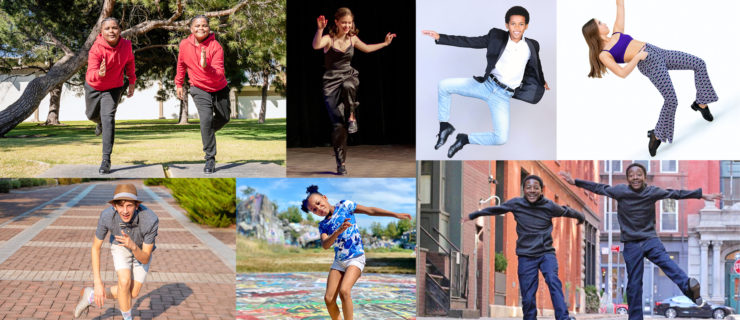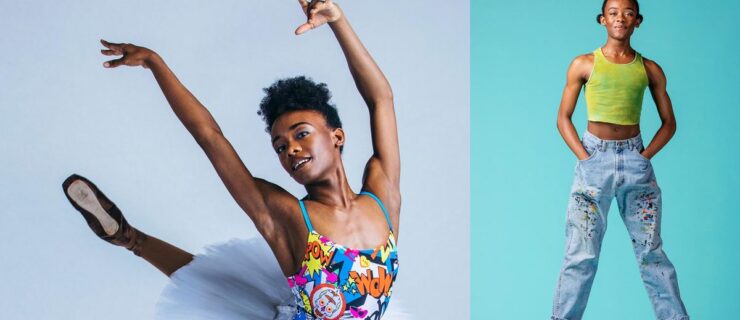Ashton Edwards Is Breaking Down Gender Barriers in Ballet
When Ashton Edwards was 3 years old, the Edwards family went to see a holiday production of The Nutcracker in their hometown, Flint, MI.
For the young child, it was love at first sight.
“I saw a beautiful, black Clara,” Ashton says, “and I wanted to be just like her.”
Ashton has dedicated 14 years of ballet training in pursuit of that childhood dream. But all the technical prowess in the world can’t help Ashton surmount the biggest hurdle—this aspiring dancer was assigned male at birth, and for the vast majority of boys and men, performing in pointe shoes hasn’t been a career option. But Ashton Edwards, who uses the pronouns “he” and “they,” says it’s high time to break down ballet’s gender barrier, and their teachers and mentors believe this passionate dancer is just the person to lead the charge.
A Childhood in Motion

Photo by Lindsay Thomas
Ashton’s mother, Latisha Edwards, says for as long as she can remember, Ashton, the sixth of seven Edwards siblings, has been in constant motion, dancing on any flat surface in the house. “He’d crash into plates in the kitchen,” she laughs. She knew she had to find something to focus all that energy.
The year after the family trip to Nutcracker, when Ashton was just 4 years old, Latisha signed them up for a dance class offered through Flint’s Head Start program. Karen Jennings, now chair of the dance division at the Flint School of Performing Arts, ran the Saturday program at the time.
“There was this little guy out in the hallway,” Jennings remembers. It was Ashton, and Jennings saw the child was copying the students in her intermediate class.
“I was afraid he was going to fall and crack his head open,” she says. “So, I invited him into the studio.”
Jennings recognized Ashton’s natural flexibility, rotation and body proportions, the physical assets that often propel a hopeful ballet dancer to success. Beyond these gifts, Ashton had what Jennings calls a “spark”: the enthusiasm and self-discipline to devote to regular ballet classes. Once the Edwards family decided Ashton would continue ballet training, Jennings was happy to place them in her classes with the more advanced students. She kept a close eye on the aspiring dancer throughout their 12 years in the Flint School of Performing Arts program—though Ashton’s journey there wasn’t always easy.
Ashton was one of only a handful of boys in the school, and one of very few Black students. And though Ashton never felt treated differently, their keen awareness of being Black in a room full of white dancers created a pressure to excel.
“I’ve had to be 12 times better than everyone else my whole life,” Ashton says. “We have no choice but to be the best if we want to be treated equally.”

Photo by Lindsay Thomas
Finding a Dance Home in Seattle

Photo by Lindsay Thomas
By the time Ashton was 11 or 12, it became clear they had the raw skills to pursue ballet seriously, and Jennings met with the Edwards family to spell out what that would mean: leaving Flint for more rigorous pre-professional training. Latisha Edwards worried about sending her child out of town, but she supported their decision to enroll in summer classes at both Chicago’s Joffrey Ballet and then at Houston Ballet.
Although Jennings believed the Joffrey would be a good long-term fit, at age 16 Ashton decided to audition for Pacific Northwest Ballet’s summer intensive. They traveled to Chicago where the Seattle-based dance company was holding a large, regional audition. PNB artistic director Peter Boal says managing director Denise Bolstad spotted Ashton before he did.
“Her eyes got bigger, then she pointed to the name and audition number on the card.” Boal immediately saw what Bolstad had noticed in Ashton. “His lines, his energy, his placement.”
But something even more special struck Boal: This teenager had the kind of stage presence that’s difficult to teach. “There are dancers that you just look at them, and they have their own special spotlight.”
Boal offered Ashton a summer spot; despite their mother’s qualms about the distance from Flint to Seattle, she let her son travel west, where they fell in love with both PNB and Seattle. After the summer, Boal accepted Ashton into the company’s Professional Division training program.

Photo by Lindsay Thomas
Chasing the Dream of Dancing On Pointe

Photo by Lindsay Thomas
While the move to PNB made sense in terms of preparation for a professional ballet career, it didn’t ensure that Ashton could immediately pursue gender-blind ballet training. In fact, the teenager didn’t even consider it at first.
“Growing up I always knew all the choreography for the female roles,” Ashton says. “I learned everything, but those were unreachable dreams, just insane fantasies.” So, when Ashton first arrived at PNB, they focused on traditional men’s classes, and on building strength, to develop into what they call a “man’s man.”
But the pandemic hit midway through Ashton’s first year at PNB. When the ballet school shut down, Ashton had time to reflect on their efforts to fit the male ballet dancer stereotype. At 5′ 6″ with long, slender limbs and androgynous facial features, they didn’t necessarily resemble a Romeo or an Albrecht. And deep down, they still harbored the dream of dancing Juliet or Giselle.
So, during quarantine in the spring and summer of 2020, Ashton embarked on a rigorous self-directed training program. They sought out online pointe technique videos, studying them carefully. A friend gave Ashton her old pointe shoes, and every day they’d go outside to the patio to practice what they’d seen in the videos.
“I was out there for six hours a day, as soon as the sun came out,” says Ashton. “And I realized, maybe this dream is possible.”
So, last fall Ashton approached Boal and Bolstad with a proposition: The dancer would continue with the official men’s curriculum if the school would allow them to pursue pointe classes, as well. And they showed the teachers what they’d learned over the summer.
“I had no hesitation,” Boal remembers. “If anyone had said to me ‘This student has danced on pointe for just nine months and this is what they’re able to do,’ I wouldn’t believe it!”

Photo by Lindsay Thomas
The Lewis and Clark of the Ballet World

Photo by Lindsay Thomas
Since classes resumed last September, Ashton has juggled a rigorous schedule: two days a week they take pointe class with their Professional Division female colleagues; the other three days they’re working with the male students, although sometimes they take that class in pointe shoes as well.
Former PNB principal dancer Jonathan Porretta, one of Ashton’s instructors, says he never knew his student wanted to dance on pointe until last fall, when Ashton started posting photos to their Instagram account.
Porretta says he has always approached teaching his classes outside male and female roles. For him, ballet is about working toward technique and developing the artist.
For his part, Porretta calls Ashton a “star,” someone he believes can help pave a new future for men, and women, in ballet. Porretta says it’s time for the art form to loosen its hide-bound gender roles.
“There will be some companies very ready to be thrust into the future of dance, while others are more set in their ways,” Porretta says. “But art is here to push boundaries and possibilities.”
PNB soloist Joshua Grant agrees. Years ago, when he was a young student, Grant’s ballet teacher suggested he take pointe classes to help strengthen his ankles. He loved dancing on pointe, but professionally it didn’t seem like an option for him. In 2006, after stints with both PNB and National Ballet of Canada, Grant auditioned for, and was hired by, Les Ballets Trockadero de Monte Carlo, the all-male troupe known for its campy send-ups of classic ballets.
“I was told it would be career suicide,” Grant recalls, because “men on pointe? That’s either drag or comedy.”
After five years as a principal dancer with the Trocks, Grant returned to PNB, where he’s back to performing traditional male roles and developing his own choreographic career. He’s currently creating a dance for Ashton and some of their fellow students, for Next Step, PNB’s choreographers’ showcase. Ashton will be on pointe. Like Porretta, Grant is excited that a young dancer like Ashton is eager to push to transform a centuries-old art form.
“I told Ashton, ‘You’re like Lewis and Clark, making your own path,'” Grant says. “‘There’s no precedent, so do what you want to do.'”

Photo by Lindsay Thomas
Looking Ahead

Photo by Lindsay Thomas
Ashton is hoping to embark on a career dancing with companies that will cast them not only in gender-blind contemporary work, but in the traditional roles from ballet’s classical canon, everything from Odette/Odile in Swan Lake to the long-coveted Clara in The Nutcracker.
“I want to be part of changing, evolving those traditions to modern day life,” says Ashton. “We can preserve those ballets, those classic works, but also make them reflect our modern world.”
Boal believes in Ashton’s ability to be a ballet change-maker; more than that, he’s convinced that ballet has to welcome gender-blind casting and men performing on pointe as more than a novelty act.
“We’re not going to laugh at this or point at it,” Boal says. “We’re going to admire it, and eventually we’re not even going to talk about it as something out of the ordinary, as it continues to evolve.”
Despite the support Ashton has received in their quest to be a nonbinary professional dancer, landing a job is tough for any ballet student, let alone for a Black dancer. But Ashton professes faith that they can make their dreams come true.
“I just decided, my entire life, this is what I’m going to do. This makes me happy, so I have to do it,” Ashton says. “There is no other way I can exist.”

Photo by Lindsay Thomas




